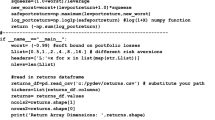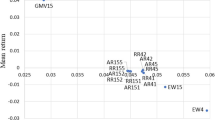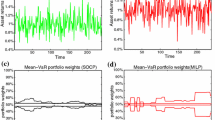Abstract
The Sharpe ratio is a way to compare the excess returns (over the risk-free asset) of portfolios for each unit of volatility that is generated by a portfolio. In this paper, we introduce a robust Sharpe ratio portfolio under the assumption that the risk-free asset is unknown. We propose a robust portfolio that maximizes the Sharpe ratio when the risk-free asset is unknown, but is within a given interval. To compute the best Sharpe ratio portfolio, all the Sharpe ratios for any risk-free asset are considered and compared by using the so-called cross-efficiency evaluation. An explicit expression of the Cross-Efficiency Sharpe Ratio portfolio is presented when short selling is allowed.
A previous version of this manuscript is available on arXiv.org.
Access this chapter
Tax calculation will be finalised at checkout
Purchases are for personal use only
Similar content being viewed by others
References
Artzener, P., Delbaen, F., Eber, J. M., & Heth, D. (1999). Coherent measures of risk. Mathematical Finance, 3, 203–228.
Ben-Tal, A., & Nemirovski, A. (1999). Robust solutions of uncertain linear programs. Operations Research Letters, 25, 1–13.
Bertsimas, D., & Pachamanova, D. (2008). Robust multiperiod portfolio management in the presence of transaction cost. Computers and Operations Research, 35, 3–17.
Chapados, N. (2011). Portfolio choice problems: An introductory survey of single and multiperiod models. Springer.
Charnes, A., Cooper, W.W., & Rhodes, E. (1978). Measuring the efficiency of decision-making units. European Journal of Operational Research, 2, 429–444.
DeMiguel, V., Garlappi, L., & Uppal, R. (2009). Optimal versus Naive diversification: How inefficient is the 1/N portfolio strategy? Review of Financial Studies, 18, 1219–1251.
Diez, D., & Christou, N. StockPortfolio package. http://cran.r-project.org/web/packages/stockPortfolio/stockPortfolio.pdf
Doyle, J. R., & Green, R. (1994). Efficiency and cross-efficiency in data envelopment analysis: Derivatives, meanings and uses. Journal of the Operational Research Society, 45, 567–578.
Galagedera, D. U. A. (2013). A new perspective of equity market performance. Journal of International Financial Markets, Institutions and Money, 26, 333–357.
Goldfarb, D., & Iyengar, G. (2003). Robust portfolio selection problems. Mathematics of Operations Research, 28, 1–38.
Jin, H., Markowitz, H. M., & Zhou, X. Y. (2006). A note on semi variance. Mathematical Finance, 16, 53–61.
Krokhmal, P., Palmquist, J., & Uryasev, S. (2002). Portfolio optimization with conditional value-at-risk objective and constraints. The Journal of Risk, 4, 11–27.
Lim, S., Oh, K. W., & Zhu, J. (2014). Use of DEA cross-eficiency evaluation in portfolio selection: An application to Korean stock market. European Journal of Operational Research, 236, 361–368.
Mansini, R., Ogryczak, W., & Grazia-Speranza, M. (2014). Twenty years of linear programming based portfolio optimization. European Journal of Operations Research, 234, 518–535.
Markowitz, H. M. (1952). Portfolio selection. Journal of Finance, 7, 77–91.
Markowitz, H. M. (1959). Portfolio selection: Efficient diversification of investment. New York, London, Sydney: Wiley.
Nawrocki, D. (1999). A brief history of downside risk measures. Journal of Investing, 8, 9–25.
Pätäri, E., Leivo, T., & Honkapuro, S. (2012). Enhancement of equity portfolio performance using data envelopment analysis. European Journal of Operational Research, 220, 786–797.
Sexton, T. R., Silkman, R. H., & Hogan, A. J. (1986). Data envelopment analysis: Critique and extensions. In R. H. Silkman (Ed.), Measuring efficiency: An assessment of data envelopment analysis (pp. 73–105). San Francisco, CA: Jossey-Bass.
Tütüncü, R. H. (2003). Optimization in finance, Advance Lecture on Mathematical Science and Information Science.
Acknowledgements
The authors thank the financial support from the Spanish Ministry for Economy and Competitiveness (Ministerio de Economa, Industria y Competitividad), the State Research Agency (Agencia Estatal de Investigacin) and the European Regional Development Fund (Fondo Europeo de Desarrollo Regional) under grant MTM2016-79765-P (AEI/FEDER, UE).
Author information
Authors and Affiliations
Corresponding author
Editor information
Editors and Affiliations
15.6 Appendix
15.6 Appendix
Proof of Proposition 2. The efficient portfolio \(i=(\sigma ^*_{MSR_i}, r^*_{MSR_i})\) that maximizes the cross-efficiency \(CE_i\), in the interval \([r_{1},r_{2}]\), is reached when
The cross-efficiency of portfolio i, \(CE_i\), depends of the risk-free rate, \(r_i\), associated with the portfolio i. We can considered \(CE_i\) as a function of \(r_i\), for \(r_i\in [r_{\min },r_{\max }]\). We can write \(CE_i(r_i)\) as follows
From expressions (15.4), (15.9) and (15.10), using notation of (15.5), we can derivate the following identities for the expected return and variance of GMV and MSR portfolios:
and write the cross-efficiency, \(CE_i(r_i)\), in terms of variable \(r_i\).
where
The function \(CE_i(R_i)\) has first derivate
It is left to show that \(CE'_i(r_i)=0\) for \(r_i=I_2/I_1\), therefore, \(r_i=I_2/I_1\) is a point with slope zero, and it is a candidate to a maximum in the interval \([r_{\min },r_{\max }]\). The second derivate of the function \(CE_i(r_i)\) is given by the following expression
and the second term of (15.28) is zero at \(r_i=I_2/I_1\), and
Since \(\Sigma ^{-1}\) is positive-definite matrix, then \((\mu -r)^T\Sigma ^{-1}(\mu -r)= a-2c r +b r^2 > 0\), with discriminant \(4(c^2-ab) < 0\), then the second derivate at \(r_i=I_2/I_1\), \(CE''(I_2/I_1)\), is less to 0.
Next, we show the expression of \(I_2/I_1\).
Now, we can write the above expression using the identities of (15.27) as follows:
and, finally we can write the maximum \(r_i\) as
\(\square \)
Proof of Proposition 3. There exists a Pythagorean relationship between the slopes of the Tangent and Global Minimum portfolios and the slope of the asymptote of \(W_{\rho }\).
From expressions (15.5), we can derivate the following identities for the \(m_{TP}\), \(m_{ah}\) and \(m_{GMV}\) slopes:
and now, we can derivate the relationship \(m_{TP}^2= m_{ah}^2+m_{GMV}^2\),
\(\square \)
Proof of Corollary 2. The maximum cross-efficiency (MCESR) portfolio in \([0,r_{GMV}^*]\) depends only of Minimal Global Variance and Tangent portfolios.
From (15.27) and (15.31), we can derivate the following expressions:
From the expression (15.21), it is left to show that (15.32) is true. \(\square \)
Rights and permissions
Copyright information
© 2020 Springer Nature Switzerland AG
About this chapter
Cite this chapter
Landete, M., Monge, J.F., Ruiz, J.L., Segura, J.V. (2020). Sharpe Portfolio Using a Cross-Efficiency Evaluation. In: Charles, V., Aparicio, J., Zhu, J. (eds) Data Science and Productivity Analytics. International Series in Operations Research & Management Science, vol 290. Springer, Cham. https://doi.org/10.1007/978-3-030-43384-0_15
Download citation
DOI: https://doi.org/10.1007/978-3-030-43384-0_15
Published:
Publisher Name: Springer, Cham
Print ISBN: 978-3-030-43383-3
Online ISBN: 978-3-030-43384-0
eBook Packages: Business and ManagementBusiness and Management (R0)




